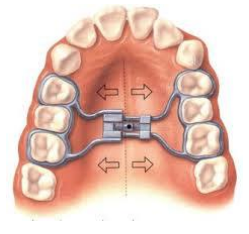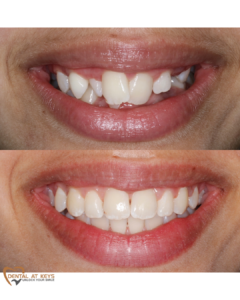What is Orthodontic Jaw Expansion?
Orthodontics is the movement of teeth. Jaw expansion refers to the enlarging of your jaws to reduce the likelihood of teeth crowding.
Signs you might need Orthodontics
The most obvious sign is crooked teeth. This means your jaw is too small to accommodate all those teeth.
This however, is NOT the only sign. Some examples of other jaw expansion signs include:
- Crossbites
- Narrow jaws
- Large overjets
Early treatment is key!
Our Orthodontic Philosophy
Orthodontics is not just simply about straightening teeth. Here at Dental at Keys, we aim to create a beautiful full smiles. We pay particular attention to the curvature, width and height of the smile. All of these aspects involve a lot more work than just straight teeth. The last thing we want for you is to have a flat straight smile (ie. Denture smile).
We also pay great attention to the profile of your face. Not only should your smile be full, but your facial profile should match it is as well. There is no point in extracting teeth in a patient who already has a sunken profile. Similarly, patients with lips that are too full should not have this worsen. This is why we say we treat the face, and not just the teeth.
Types of Orthodontic Jaw Expansion we offer:
 Maxillary Expansion (also known as RME)
Maxillary Expansion (also known as RME)
Our top jaw (Maxilla) is made of two separate bones joined together by a line (mid-palatal suture). When we are young the bones have not fused together, and therefore we are able to stretch the two bones apart. This forms a gap between the bones which with time fills up with bone. When your top jaw is narrow, or if there is insufficient room for all your permanent teeth to fit into your top jaw, your dentist may prescribe a fixed or removable maxillary expander. The expander sits around your first molars and can extend to some of your teeth further forward. The expander may or may not have a layer of plastic covering your upper back teeth. The timing of upper expansion is crucial and is typically done in younger patients aged 7 to 10.
Mandibular Expansion
Likewise, your lower jaw can also be expanded, to a certain extent and prior to the eruption of your lower adult canine teeth.
Sagittal Expansion
Another version of expansion uses the incisal suture to push the front or back of your jaws outward (or backwards). This is typically used in cases where there is sufficient sideways expansion but insufficient space for the teeth to come out (front to back
How do you make an Expander?
Depending on whether you need a Fixed (glued-in) or removal jaw expander, the process is fairly similar and involves:
- Moulds or scans are taken of your teeth.
- The jaw expander is made at our local orthodontic lab.
- If a fixed teeth expander is to be made, we will place separators (rubber rings) between your back teeth.
- Once the jaw expander is complete, we test the fit of the appliance and adjust it to fit your teeth. Fixed expanders will be glued-in at this appointment.
- You will attend regular appointments to monitor the appliance and expansion of your jaws – generally up to a period of 1 to 2 years.
Will I need any further treatment?
After treatment with a Orthodontic Expander, it is very likely that you will need to have further treatment such as braces or clear aligners to straighten your teeth. Each case is different, and your dentist will inform you of your tailored treatment plan.
Interested in Jaw Expansion Treatment?
Contact us now on (03) 8899 6331 or check out our other services here.
Book Online
Need help with your dental payments?
We have a variety of Payment Plans available – giving you the flexibility of paying for your Orthodontic Jaw expander later.
Payment PlansFrequently Asked Questions
- How much does a Jaw expander cost?
- The cost depends on the length of treatment and number of appliances used. The cost for this can range from $1,000 (including all review appointments) for a simple appliance up to roughly $3,000 for more complex expanders.
- Do you need to to refer me to a specialist to do my Orthodontics?
- Whilst we are able to do most orthodontic work here at Dental at Keys (except braces), we occasionally may need to refer you to an Orthodontist.
- Do I need to wear a retainer?
- Yes, you must wear a retainer (for life) after your treatment is complete as your jaw expansion WILL relapse.
- How long does Orthodontic treatment take?
- This can range from a few months for cosmetic or simple cases to several years for complex cases.

